Exploring data analysis
The data in this study consist of variables; lecture agreeableness, student agreeableness, student extroversion, lecture extroversion. In this exploring of data we will look at descriptive statistics, and relation between student agreeableness and lecture agreeableness, between student extroversion and lecture extroversion, between student agreeableness and lecture extroversion; between student extroversion and lecture agreeableness. The analysis of the data ensures that the data is normally distributed and hence can be used to perform other statistical analysis (Kelle, 2014).
The descriptive statistic
Table 1: Descriptive statistics
From above descriptive statistics, we can observe that the total observed students are 418 for student extroversion; the value of mean of student extroversion is 30.1029, while the standard deviation is 6.31897. The variable student agreeableness has the value of the observed sample equal to 413; the mean of the student agreeableness is equal to 46.5157, and the standard deviation of 7.45295. The value of the observed sample on the agreeableness in lecture is 417, the mean value of the lecture agreeableness is equal to 8.8825, and the standard deviation is equal to 9.57577. The value of the observed lecture extroversion is 283, the mean value of the lecture extroversion is equal to 12.9576 and the standard deviation is 6.94494.
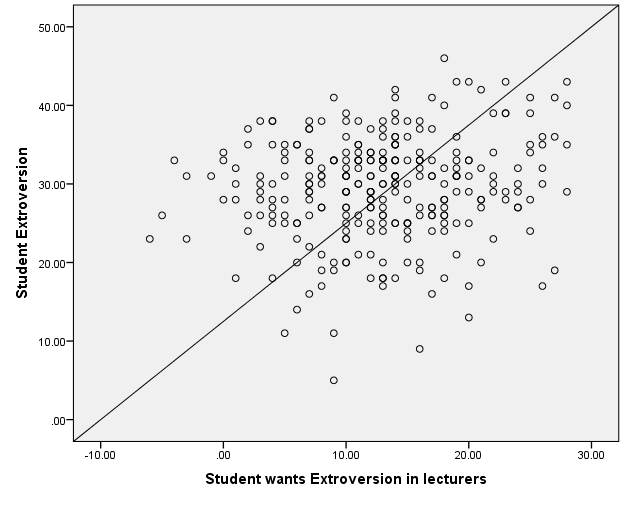
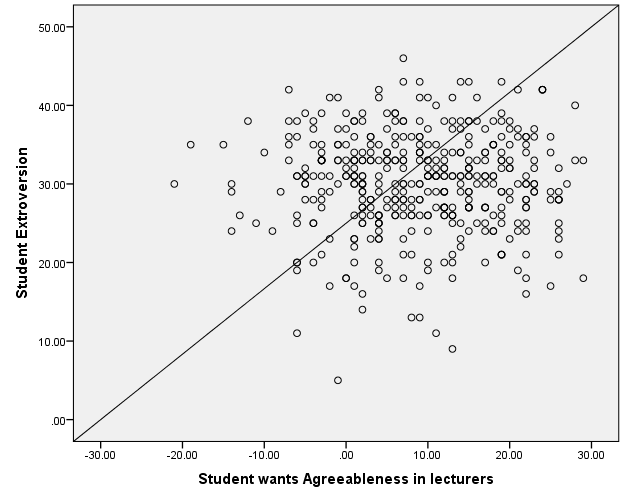
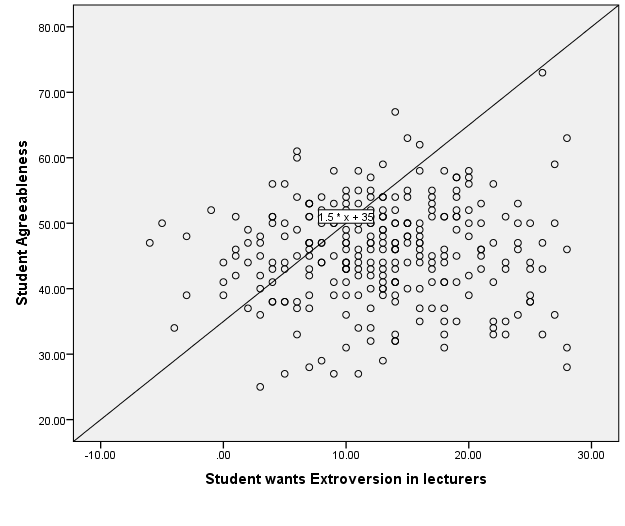
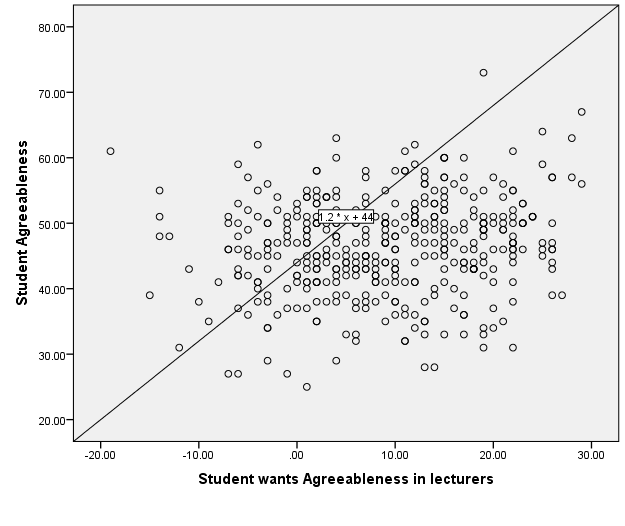
From the scatter plot between the student extroversion and the student want extroversion in lecturers, there is a positive relationship between the student extroversion, and the student wants extroversion in lecturers. This means that a rise in the students extroversion lead to a rise in the student wants extroversion in lecturers. From the scatterplot between the student agreeableness and the students wants agreeableness in lecturers. There is a positive relationship between the student agreeableness and the student wants agreeableness in lecturer. This means that an increase in the student agreeableness will result to an increase in the students wants agreeableness in lecturer. From the scatterplot between the student extroversion and student wants agreeableness in lecturers. There is a positive relationship between the student extroversion and the student agreeableness in lecturers. This means that an increase in the student extroversion will lead to an increase in the student want agreeableness in lecturer. From the scatterplot between the student agreeableness and the students wants extroversion in lecturers. There is a positive relationship between the student agreeableness and the student wants extroversion. This means that there is a positive relationship between the student agreeableness and the student wants extroversion in lecturers.
Missing values in the data
In all the values, we observed that they consisted of the missing values. We decided to replace the missing values with the mean of the variables as they were obtained. This is to ensure that the mean of these variables does not introduce the bias in the variable.
Correlation analysis
Table 2: correlation analysis table for the corrected variables
From the correlation analysis, we can see that the value of correlation between the student extroversion and the student agreeableness is 0.079 which has a two tailed significant value of 0.103. This implies that there is no correlation between the variable student extroversion and the student agreeableness. The correlation between the variable student extroversion and the student wants agreeableness in lecturers is equal to 0.130 which has a two tailed significant value of 0.007. This implies that there is no correlation between the variable student extroversion and the student wants extroversion in lecturers. The value of correlation between the variable student extroversion and the variable student wants agreeableness in lecturers is 0.004 which has a two tailed significant value of 0.931, which is greater than the 0.05 level of confidence. This implies that there is no correlation between the variable student extroversion and the variable student wants agreeableness in lecturers. The correlation value between the student agreeableness and the variable student wants extroversion in lecturers is equal to 0.042 which has a two tailed significant value of 0.387 which is greater than the 0.05 level of confidence. This implies that there is no significant correlation between the variable student agreeableness and the student want extroversion in lecturers. The correlation between the variable student agreeableness and the variable student want agreeableness in lecture is 0.158, which has a two tailed significant value of 0.001. This implies that there is a significant correlation between the variable student agreeableness and the variable student want agreeableness in lecturers.
The regression analysis
Table 3: the regression analysis output
From the regression analysis, we observe that the value of the F- statistic of the variable student extroversion is 1.678 which has a significant value of 0.011 which is smaller than the 0.05 level of confidence. This implies that the dependent variable student wants extroversion in lecturers with the independent variable student extroversion. The overall regression model has a T- statistic value of 1.678 which has a two tailed significant value of 0.011. Since the significant value is less than the 0.05 level of confidence we can say that there is sufficient evidence that the regression model is significant and can be used to predict the student wants extroversion in lecturer. The coefficient of intercept has an F- value of 765.954, which has a significant value of 0.000 which is less than the 0.05 level of confidence. Since the significant value is less than the 0.05 level of confidence we can conclude that the intercept is significant to the model.
Multiple regression
Table 4: Multiple regression
From the Multiple regression between the dependent variable, student wants extroversion and the independent variables; age, gender, and student extroversion. From the multiple regressions we can observe that the value of the F- statistic is 1.978 which has a significant value of 0.003 which is less than the 0.05 level of confidence. This implies that the independent variable student extroversion can be used to predict the student want extroversion in lecturer. The value of the F- statistic of the variable age is equal to 0.834 which has a significant value of 0.686 which is greater than the 0.05 level of confidence. This implies that there is no significant relationship between the dependent variable students wants extroversion in lecturer. The correlation between the variable gender and the dependent variable student wants extroversion in lecturer is not significant. The variable student extroversion has an F- value of 3.961 which has a significant value of 0.048 which is less than the 0.05 level of confidence. This implies that there is significant relationship between the dependent variable students wants extroversion in lecturer. From the regression analysis, the F- value of the association between the student extroversion and the age and the dependent variable is 1.363 which has a significant value of 0.040. This implies that there is significant relationship between the dependent variable and the association between age and student extroversion. The regression analysis between the dependent variable students wants extroversion and the association between age and gender has an F- statistic of 2.617 which has a significant value of 0.026 which is less than the 0.05 level of confidence. This implies that there is significant relationship between the dependent variable students’ wants extroversion in lecturer and the association of age and gender. The coefficient of association between the student extroversion, age and the gender has a F- statistic value of 0.665 which has a two significant value of 0.864 which is less than the 0.05 level of confidence. Since the significant value is less than the 0.05 level of confidence, we conclude that there association of the student extroversion, age and the gender is not significant to the regression model. The variable student extroversion and the gender have an f- statistic of 0.828, which have a significant value of 0.683 which is less than the 0.05 level of confidence. Since the significant value is greater than level of confidence we conclude that the association between the student extroversion and the gender we conclude that they are not significant (Kutner, Nachtsheim, Neter & Li, 2005).
The diagnosis test
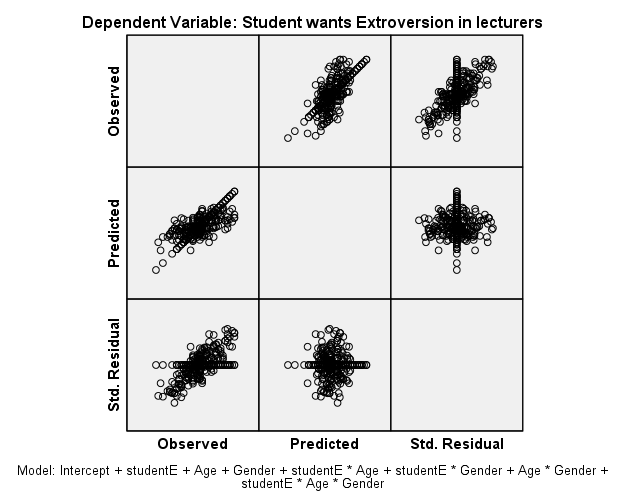
From the diagnosis test, we can observe that the assumptions of normality are satisfied by all the independent variables. The multiple regression variables usually assume that the independent variables have a normal distribution. It indicated that all the independent variables have a normal distribution. The above results do not differ with correlation analysis done.
References
Kelle, G. (2014). Statistics for Management and Economics, (10thed.). New York: McGraw-Hill/Irwin.
Kutner, M., Nachtsheim, C., Neter, J., & Li, W. (2005). Applied Linear Statistical Models (5th ed.). New York: McGraw-Hill/Irwin.